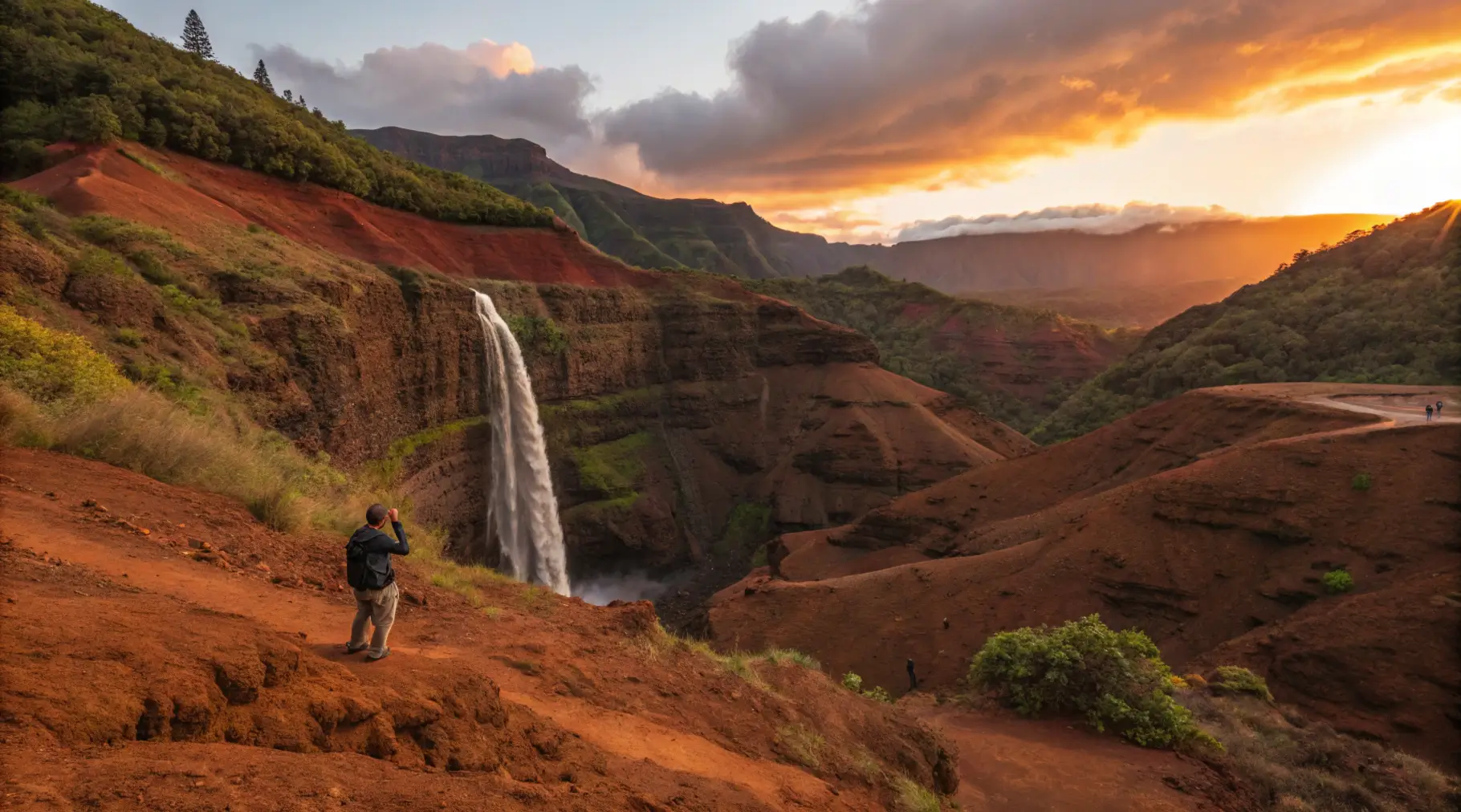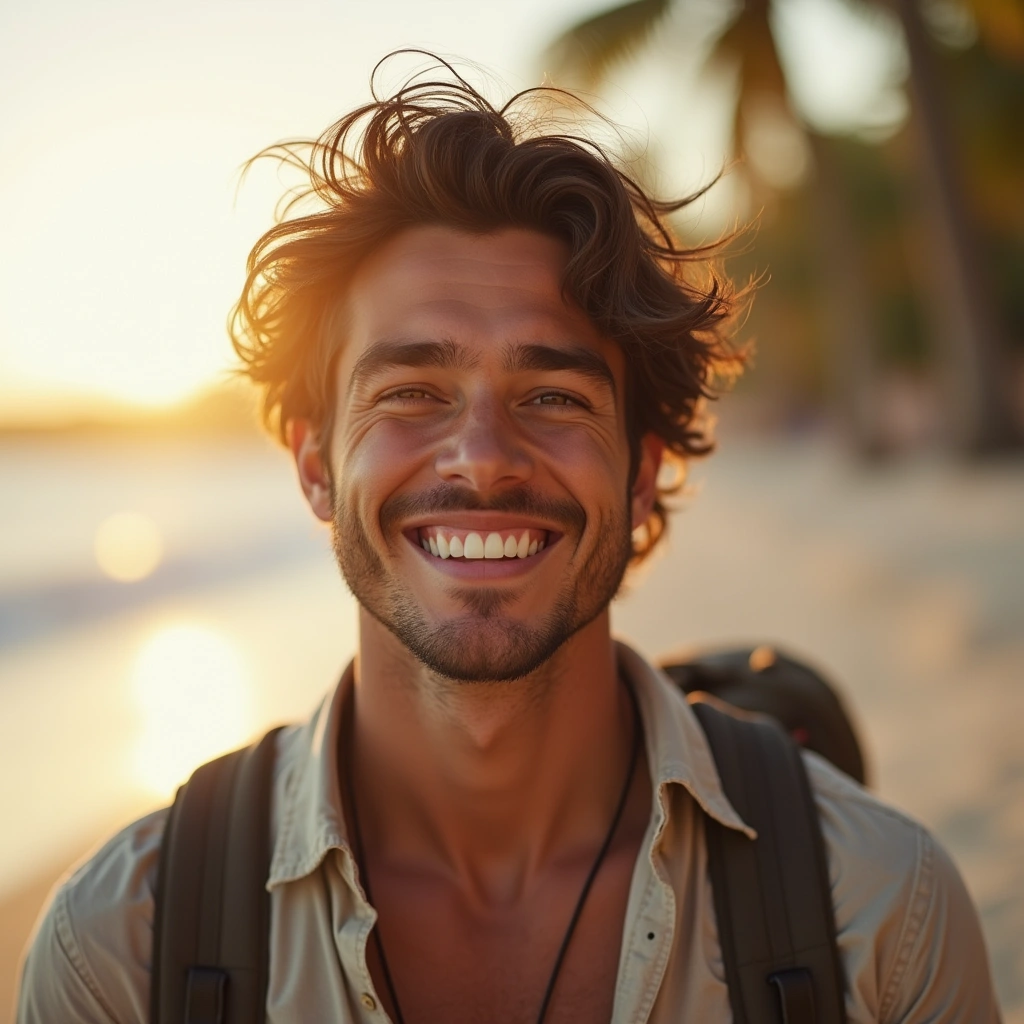Introduction
Imagine a waterfall that seems to defy nature itself—cascading not with crystal clear water, but with rich, rusty-red flows that paint the landscape in dramatic hues. This is red dirt waterfall kauai, one of the island’s most photogenic and unusual natural wonders. Tucked along the scenic drive through Waimea Canyon, this remarkable roadside attraction captivates visitors with its striking contrast of vibrant red earth against the lush green surroundings.
Unlike many of Kauai’s treasures that require challenging hikes or guided tours, this gem sits conveniently accessible right off the road—yet surprisingly, many visitors drive right past without knowing what they’re missing. Whether you’re a photography enthusiast seeking unique shots, a nature lover fascinated by geological oddities, or simply looking for memorable stops along your Kauai adventure, the Red Dirt Waterfall deserves a place on your itinerary.
In this definitive guide, we’ll take you beyond the quick roadside snapshot to truly understand this natural phenomenon—from the fascinating geology that creates its distinctive color to exactly where to park, when to visit for the best experience, and how to capture photos that will be the envy of your social media followers. By the time you finish reading, you’ll have insider knowledge that most Kauai visitors never discover about this easily accessible yet often overlooked natural wonder.
Table of Contents
What Exactly Is red dirt waterfall kauai?

The Visual Spectacle
The Red Dirt Waterfall is a mesmerizing sight that challenges what most people expect from a waterfall. Instead of the typical white cascade against dark rocks, visitors are treated to an almost otherworldly scene where water flows in varying shades of orange and red, stained by the island’s famous red soil. During heavy rainfall, the contrast becomes even more dramatic as the rust-colored water creates a striking display against the verdant backdrop of Waimea Canyon.
What makes this waterfall particularly special is its accessibility combined with its uniqueness. Many natural wonders require significant effort to reach, but here, Mother Nature has placed one of her most unusual creations right alongside the road for all to appreciate.
The Geology: Why So Red?
The stunning red color isn’t just for show—it’s a fascinating geological story millions of years in the making. Kauai is the oldest of the main Hawaiian islands, giving its volcanic soil extensive time to weather and develop distinct characteristics. The island’s red dirt is actually laterite soil rich in iron oxide (essentially, rust). When rain falls on Kauai’s red hillsides, it becomes saturated with these iron particles.
This weathering process, called laterization, happens when volcanic basalt rock decomposes in hot, wet tropical environments over extremely long periods. The resulting iron oxide gives the soil its distinctive red-orange hue, which can range from bright rust to deep burgundy depending on mineral concentration and moisture levels.
When heavy rains wash over these iron-rich hillsides, particularly in the Waimea Canyon area, the water carries the fine red particles downstream, creating seasonal waterways that look more like flowing cinnamon than water. The Red Dirt Waterfall is simply one of the most accessible and photogenic places to witness this remarkable natural phenomenon.
Flow Patterns and Seasonality
One of the most common questions visitors ask is whether the waterfall flows year-round. The answer is: it depends. The red dirt waterfall kauai is not a massive, permanent waterfall fed by a large river system. Rather, it’s a seasonal cascade that responds dramatically to rainfall patterns.
During Kauai’s wetter winter months (approximately November through March), the chances of seeing the falls in full flow increase significantly. After heavy rain, the waterfall can transform from a trickle to an impressive cascade within hours. During extended dry periods, particularly in summer, you might find only a subtle hint of moisture or even completely dry conditions.
This variability is actually part of what makes visiting exciting—each experience can be different, and catching the falls after a good rain offers the most spectacular views of its rich red color.
Cultural Significance
While not holding the same level of cultural significance as some of Kauai’s ancient sites or larger waterfalls, the red dirt of the island does play a role in local culture. The distinctive soil has been used historically for dyes and pigments. Today, you’ll find “Red Dirt Shirts” sold as popular souvenirs across the island—t-shirts dyed using the natural red soil in an eco-friendly process.
The area around Waimea Canyon, nicknamed “The Grand Canyon of the Pacific” Waimea Canyon is a designated state park known for its dramatic elevation and colorful stratigraphy—you can explore more details on Waimea Canyon State Park via Wikipedia. by Mark Twain, holds significant importance in Hawaiian cultural history. While the waterfall itself doesn’t feature prominently in Hawaiian legends, it represents the powerful geological forces that shaped this sacred island landscape.
Pinpoint Location & Getting There
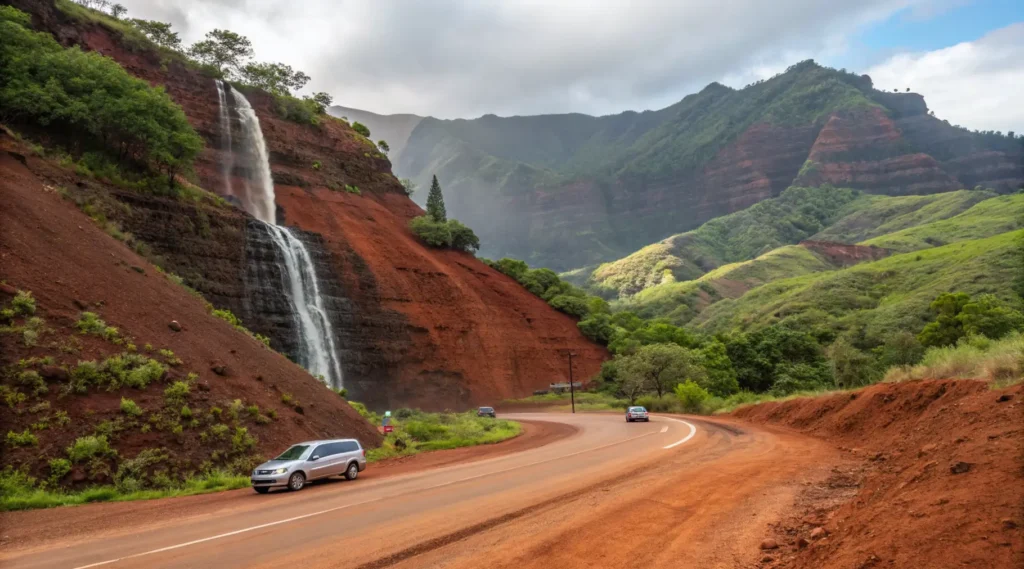
Exact Location
Finding the red dirt waterfall kauai is straightforward once you know exactly where to look. It’s located along Waimea Canyon Drive (Highway 550) at approximately Mile Marker 23, as you ascend through Waimea Canyon State Park toward Koke’e State Park.
The waterfall is on the mountain side of the road (east side), where the vibrant red cliff face meets the roadway. Unlike many attractions, there’s no official signage marking the spot, which is why many visitors miss it entirely.
Directions From Popular Areas
From Lihue (Airport):
- Head west on Highway 50 toward Waimea town (approximately 27 miles, 45 minutes)
- Continue through Waimea town
- Turn right onto Waimea Canyon Drive (Highway 550)
- Ascend approximately 6.5 miles to Mile Marker 23
- Watch carefully on your right for the red cliff face with water
From Poipu:
- Head west on Poipu Road, then north on Highway 50
- Continue through Koloa and Kalaheo
- When you reach Waimea town, turn right onto Waimea Canyon Drive (Highway 550)
- Continue as above, approximately 6.5 miles to Mile Marker 23
From North Shore (Princeville/Hanalei):
- Take Highway 56 south, which becomes Highway 50
- Follow Highway 50 through Lihue and continue west to Waimea town
- In Waimea, turn right onto Waimea Canyon Drive (Highway 550)
- Continue as above to Mile Marker 23
Parking Details
Parking at Red Dirt Waterfall requires some advance planning, as there’s no designated parking lot. Instead, you’ll need to utilize one of several small pullouts along Highway 550 near Mile Marker 23. Here’s what to know:
- Look for wider sections of shoulder approximately 100 feet before or after the waterfall
- The most common parking spot is a small dirt pullout just past the waterfall on the right side
- During busy seasons (summer, holidays), arrive early as limited parking spots fill quickly
- Be sure your vehicle is completely off the road and not blocking traffic
- Engage your parking brake fully—the road has significant inclines
Safety Note: Highway 550 can be winding with occasional blind corners. Use extreme caution when pulling over and especially when crossing the road. If possible, park on the same side as the waterfall (the right/east side heading uphill) to avoid crossing.
Accessibility Considerations
The viewing experience at Red Dirt Waterfall offers different levels of accessibility:
- Roadside Viewing: The waterfall is visible from the road with no hiking required—ideal for those with mobility limitations. You can appreciate the red-tinged water and cliff face directly from the pullout areas.
- Closer Viewing: Getting closer to the falls requires navigating a short but potentially slippery slope. This is not wheelchair accessible and may be challenging for those with mobility issues or young children.
- Stroller & Elderly Friendly? The roadside viewing area is suitable for all visitors, including elderly travelers and those with strollers. However, keep children well away from the road edge, as there are no guardrails or barriers in most sections.
The lack of developed infrastructure is part of what keeps this spot feeling like a hidden gem, but it also means visitors should exercise appropriate caution, especially with children or those with mobility challenges.
The Visual Experience
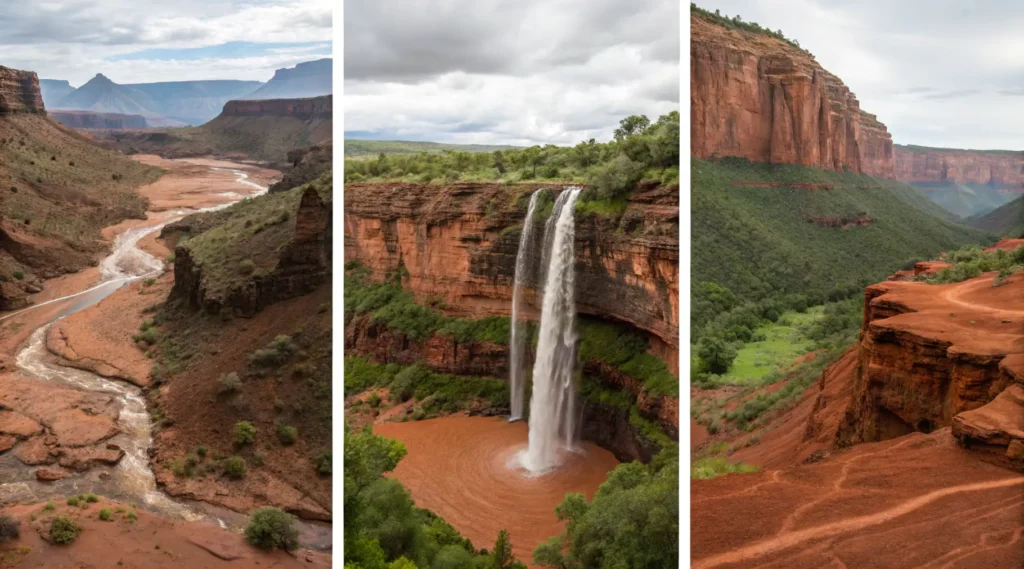
The Photographic Opportunity
What makes red dirt waterfall kauai truly special is its unique visual impact. Unlike the towering cascades elsewhere on Kauai, this modest waterfall stands out because of its extraordinary coloration and the striking contrast it creates against the surrounding landscape.
The waterfall typically presents as a series of narrow red-orange streams flowing down a deeply corrugated cliff face. During heavy rainfall, these individual trickles can merge into broader flows, creating the appearance of the entire hillside weeping rusty tears. The red water carved channels through the laterite soil create intricate patterns across the cliff face—a photographer’s dream for texture and color studies.
Depending on recent rainfall, soil conditions, and lighting, the color can range from bright terracotta to rich burgundy. This variability means that even repeat visitors often see something new and different with each visit.
Photography Showcase
Close-up showing the vibrant red waters against the textured cliff face
Wide-angle view showing the waterfall in context with Waimea Canyon’s landscape
The waterfall at peak flow following a significant rainfall event
Morning light illuminating the red cliff face, enhancing the color contrast
The Surrounding Context
What many visitors appreciate about Red Dirt Waterfall is not just the feature itself, but how it fits within the broader landscape of Waimea Canyon. From certain vantage points, you can capture not only the red cascade but also glimpses of the deeper canyon beyond, with its layers of red, brown, and green creating a painter’s palette of natural colors.
Looking across the road from the waterfall provides views of the opposite canyon wall, offering perspective on how the entire landscape shares this remarkable red quality. On clear days, you might even catch distant views of the ocean from nearby pullouts, creating the remarkable juxtaposition of red earth, green foliage, and blue sea that makes Kauai so visually stunning.
Best Times to Visit & Photography Tips
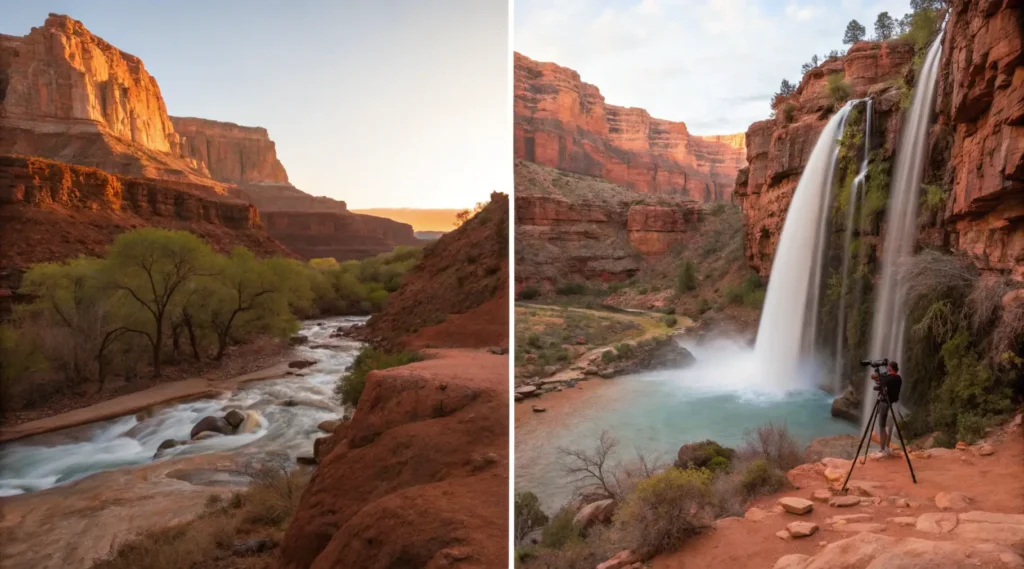
Optimal Timing for Your Visit
Time of Day: The Red Dirt Waterfall looks different throughout the day as the light changes. For photographers, early morning (before 10 AM) generally offers the best lighting conditions. The morning sun illuminates the red cliff face directly, making the colors appear more vibrant and reducing harsh shadows. Late afternoon can also produce interesting results as the softer light brings out different tonalities in the red earth.
Midday visits, while convenient for most travelers, often result in harsher contrasts and potentially washed-out colors in photographs due to the direct overhead sun. However, if passing through the area during midday is your only option, it’s still absolutely worth stopping—just be prepared to adjust your camera settings accordingly.
Seasonal Considerations:
- Winter (November-March): This is generally the wetter season on Kauai, particularly on the mountain slopes. After rainstorms, the waterfall is typically at its most dramatic and colorful. The trade-off is potentially cloudier conditions for photography.
- Summer (April-October): Typically drier with clearer skies, but the waterfall may be reduced to a trickle or even dry completely during extended drought periods.
- Ideal Scenario: The perfect conditions occur 1-3 days after good rainfall, when the flow remains strong but the sun has returned.
Avoiding Crowds: While never as crowded as major tourist attractions, the limited parking can make it feel busy during peak times:
- Weekdays generally see fewer visitors than weekends
- Early morning (before 9 AM) or later afternoon (after 3 PM) typically offer more solitude
- The busiest periods are usually between 10 AM and 2 PM, especially when tour vans make their stops
Photography Tips for Stunning Shots
Equipment Recommendations:
- Smartphone Photographers: Modern smartphone cameras can capture excellent images here. Use HDR mode to balance the bright sky against the darker cliff face.
- DSLR/Mirrorless: A polarizing filter is highly recommended to reduce glare and enhance the red colors. A neutral density (ND) filter can also help capture longer exposures of the flowing water.
- Lenses: A standard zoom (24-70mm equivalent) covers most needs. Wide-angle (16-24mm) helps capture the waterfall in its landscape context.
- Tripod: Helpful for longer exposures, especially in lower light or for capturing silky water effects.
Composition Strategies:
- Include some surrounding vegetation for scale and color contrast
- Try both vertical and horizontal orientations—vertical often works well to show the full height of the cliff face
- Look for natural framing elements like overhanging branches or rock formations
- Experiment with different perspectives—from across the road, from slightly below, or from different pullouts
- Consider including the road in some shots to convey the accessibility story of this unique feature
Technical Settings:
- A slightly slower shutter speed (1/15 to 1/60) can create a pleasing soft effect in the flowing water
- Bracket your exposures when dealing with bright sky and darker cliff face
- Slightly boosting saturation in post-processing can help convey the true visual impact of the red colors
What to Expect & Essential Tips
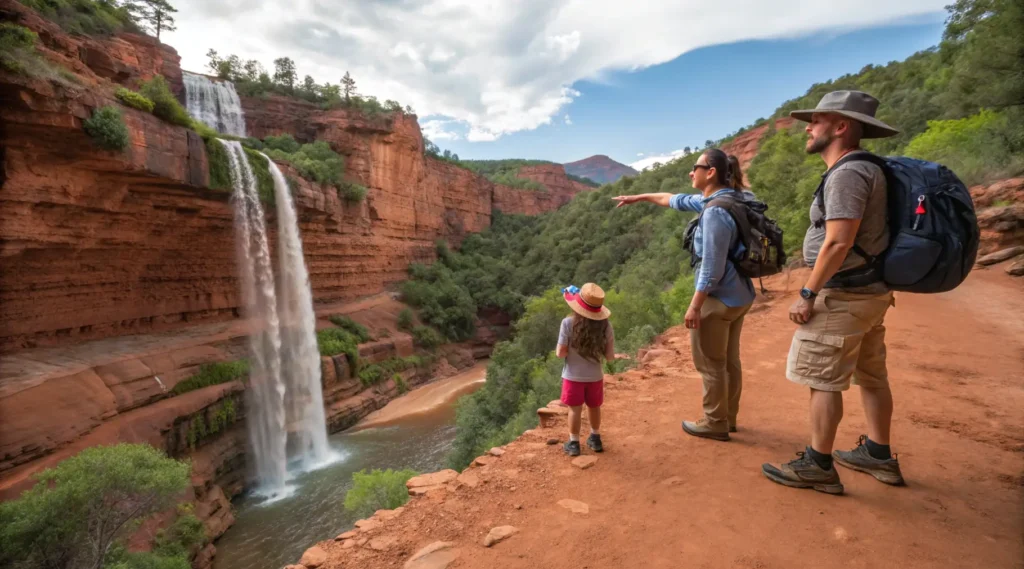
Planning Your Visit
Duration: The Red Dirt Waterfall is primarily a quick photo stop rather than a lengthy attraction. Most visitors spend between 15-30 minutes here, which allows time to view the falls from different angles, take photos, and appreciate the unique geological feature. If you’re a dedicated photographer or particularly fascinated by the geology, you might spend up to an hour exploring different vantage points.
Facilities: It’s important to note that there are no facilities directly at the red dirt waterfall kauai. The nearest public restrooms are located at the main Waimea Canyon Lookout (about 10 minutes further up the road) and at the entrance to Koke’e State Park. There are no food vendors, water fountains, or trash receptacles at the waterfall itself.
Cell Service: Cell phone reception can be spotty in parts of Waimea Canyon. Don’t count on having reliable service at the waterfall location, though many visitors report at least intermittent coverage from major carriers.
What to Bring
For the most comfortable and enjoyable visit, consider bringing:
- Water: Staying hydrated is important in Hawaii’s climate, even for short stops
- Sun protection: Hat, sunglasses, and sunscreen are essential (reef-safe sunscreen is required by law in Hawaii)
- Camera: Whether smartphone or dedicated camera, you’ll want to capture this unique sight
- Appropriate footwear: Even for roadside viewing, closed-toe shoes with good traction are recommended over flip-flops if you plan to get closer to the falls
- Light rain jacket or poncho: Weather in the canyon can change quickly
- Small towel: Useful for wiping off red dirt from hands or equipment
Safety Considerations
While easily accessible, there are several important safety considerations to keep in mind:
- Road safety: Highway 550 is a winding mountain road with occasional blind curves. Use extreme caution when pulling over, exiting your vehicle, or crossing the road.
- Edge awareness: The areas near the waterfall can have unstable edges and slippery surfaces, especially after rain. Stay on visible paths and avoid climbing on the red dirt banks, which can crumble unexpectedly.
- Children: Keep close watch on children, as there are no safety barriers between the viewing areas and the road or cliff edges.
- Weather awareness: Conditions can change rapidly in the canyon. Heavy rain can increase runoff and make surfaces more slippery, while also potentially creating flash flood conditions.
Environmental Responsibility
The Red Dirt Waterfall area, like all of Kauai, requires visitors to practice responsible tourism:
- Leave No Trace: Pack out everything you bring in. There are no trash facilities at the falls.
- Stay on established areas: Avoid creating new paths or disturbing vegetation.
- No sampling: While it might be tempting to collect a small sample of the famous red dirt, removing any natural material is discouraged and may be prohibited in protected areas.
- Respect the water: The waterfall and its tributaries feed into larger watershed systems. Avoid introducing any contaminants (including sunscreen) into the water.
Can You Swim at red dirt waterfall kauai?
This is one of the most frequently asked questions, and the answer is a clear no. Swimming at Red Dirt Waterfall is not recommended or appropriate for several important reasons:
- The waterfall is generally shallow with minimal pooling areas
- The location directly alongside a busy road presents safety hazards
- The water quality, containing high mineral content and surface runoff, is not suitable for recreational water contact
- The area is not designed or designated for swimming with no facilities or safety measures
For swimming experiences on Kauai, numerous beach parks and designated swimming areas offer safer, more appropriate options.
Beyond the Falls – Your Waimea Canyon Itinerary
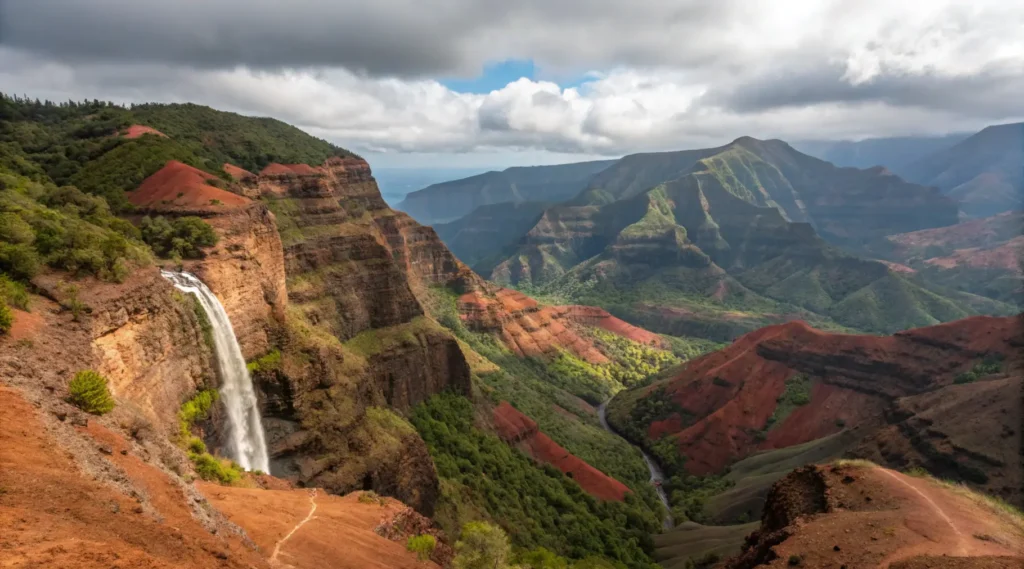
The red dirt waterfall kauai makes an excellent stop as part of a broader Waimea Canyon exploration. Here’s how to integrate it into a well-rounded day trip:
Nearby Viewpoints and Attractions
Waimea Canyon Lookout (2 miles further): The main lookout offers spectacular panoramic views of the “Grand Canyon of the Pacific” with its 3,000-foot deep gorge. Facilities include restrooms, information kiosks, and souvenir vendors. Plan to spend 15-30 minutes enjoying the views and orientation.
Puʻu Hinahina Lookout (4 miles further): This less-crowded viewpoint offers not only canyon views but also, on clear days, glimpses of the Niʻihau Island across the channel. The different perspective complements what you’ll see at the main lookout.
Kalalau Lookout (7 miles further): Continue to the end of Highway 550 for breathtaking views of the famous Kalalau Valley and the Na Pali coastline. This is one of the most photographed views in Hawaii and provides a completely different landscape from the canyon—lush, green valleys meeting the blue Pacific.
Recommended Short Hikes
If you’re interested in stretching your legs beyond roadside attractions, consider these accessible trails:
Canyon Trail to Waipoo Falls (Moderate, 3.6 miles round trip):
- Trailhead located near mile marker 14
- Offers close-up views of the canyon and a vista point above 800-foot Waipoo Falls
- Allow 2-3 hours for the complete experience
Cliff Trail (Easy, 0.5 miles round trip):
- Short nature trail near the Koke’e Museum
- Perfect for families or those with limited time
- Features native plants with interpretive signs
- Allow 30 minutes
Alakaʻi Swamp Trail (Moderate to challenging, various lengths):
- Access from the end of Highway 550
- Boardwalk sections through unique high-elevation swamp
- Stunning biodiversity and potential for rare bird sightings
- Variable length options from 2-8 miles round trip
Sample Itinerary Including red dirt waterfall kauai
Morning:
- 7:00 AM: Depart from coastal accommodations
- 8:30 AM: Arrive at Red Dirt Waterfall (Mile Marker 23) for optimal morning light
- 9:00 AM: Continue to Waimea Canyon Lookout
- 9:45 AM: Visit Puʻu Hinahina Lookout
- 10:30 AM: Arrive at Koke’e Museum for orientation and information
Midday:
- 11:00 AM: Picnic lunch at Koke’e State Park picnic area
- 12:00 PM: Short hike on Cliff Trail or more ambitious Canyon Trail
Afternoon:
- 2:30 PM: Visit Kalalau Lookout and Puʻu o Kila Lookout for afternoon light
- 3:30 PM: Begin return journey down the mountain
- 4:00 PM: Optional second stop at Red Dirt Waterfall to see how afternoon light changes the scene
- 5:30 PM: Return to coastal areas in time for dinner
Dining Options:
- Koke’e Lodge: Rustic restaurant near the museum serving local comfort food
- Waimea Town: Several excellent dining options available on your return journey, including traditional Hawaiian plate lunches and local seafood
Your Questions Answered (FAQ)
Frequently Asked Questions About red dirt waterfall kauai
Is Red Dirt Waterfall always flowing?
No, the waterfall is seasonal and weather-dependent. It flows most impressively after periods of rain, particularly during Kauai’s wetter winter months (November-March). During extended dry periods, especially in summer, it may reduce to a trickle or dry up completely.
Why is the water red?
The water appears red because it picks up particles of iron-rich laterite soil as it flows across Kauai’s famous red dirt. This soil gets its color from iron oxide (essentially rust) that has developed over millions of years as the island’s volcanic rock weathered in tropical conditions.
Where exactly is the parking for Red Dirt Waterfall?
There is no designated parking lot. Visitors typically use small pullouts along Highway 550 near Mile Marker 23. The most common parking area is a widened shoulder section approximately 100 feet past the waterfall when heading uphill.
Can you swim at red dirt waterfall kauai?
No, swimming is not appropriate here. The waterfall is shallow, located alongside a busy road, and the water quality is not suitable for recreational contact. Kauai offers many designated swimming beaches and pools for safe water activities.
How tall is the Red Dirt Waterfall?
The waterfall cascades down a cliff face approximately 30-40 feet in height, though this can appear more or less dramatic depending on water flow and viewing angle.
Is there an entrance fee to see red dirt waterfall kauai?
No, there is no fee to view the waterfall itself as it’s located alongside a public highway. However, if you continue further up into Koke’e State Park or Waimea Canyon State Park, non-resident visitors are required to pay a state park entrance fee and parking fee.
Is the Red Dirt Waterfall natural or man-made?
The waterfall is entirely natural. It’s formed by natural drainage patterns directing rainwater down the canyon’s slopes. However, the road construction may have influenced the exact path of water flow in some sections.
Can I bring home some of the red dirt as a souvenir?
While small samples of red dirt from appropriate areas are sometimes collected by visitors, it’s generally discouraged to remove natural materials from Hawaii’s landscape, especially in protected areas. Instead, consider purchasing official “Red Dirt Shirts” from local vendors as a sustainable souvenir.
How long should I plan to spend at the waterfall?
Most visitors spend 15-30 minutes at the site, which allows time to view the falls from different angles and take photographs. Dedicated photographers might spend up to an hour exploring different compositions.
Is the Red Dirt Waterfall suitable for children?
Yes, children can certainly view and appreciate the waterfall, but parental supervision is essential due to the roadside location and uneven terrain. There are no safety barriers between viewing areas and the road.
What if it’s raining when I visit?
Rain actually enhances the waterfall experience by increasing water flow and intensifying the red color. However, be aware that heavy rain can make surfaces more slippery and potentially create hazardous conditions. Use appropriate caution and rain gear.
Is the red dirt staining? Will it ruin my clothes or shoes?
Yes, Kauai’s red dirt is notorious for staining light-colored fabrics. If you plan to get close to the falls or walk on red dirt areas, consider wearing darker clothing or items you don’t mind getting stained. The red color can be difficult to completely remove from fabrics and shoes.
Author’s Experience
As someone who has visited Kauai multiple times and photographed the Red Dirt Waterfall in various conditions, I’ve developed a special appreciation for this unique natural feature. My most memorable visit was after three days of steady rain when the entire cliff face had transformed into a series of vibrant red cascades that looked almost surreal against the lush green surroundings.
What continues to fascinate me about this location is how it changes with each visit. The intensity of color, flow patterns, and even the surrounding vegetation evolve throughout the seasons and years. I’ve consulted with local geologists to better understand the unique iron oxide processes that create this phenomenon and have spoken with longtime Kauai residents who consider the red dirt waterfall kauai a perfect symbol of the island’s distinctive geology.
While researching this guide, I also connected with professional photographers who specialize in Kauai landscapes to gather their insights on capturing this distinctive feature at its best. Their contributions, combined with multiple personal visits throughout different seasons, inform the practical recommendations throughout this guide.
Conclusion
The Red Dirt Waterfall represents something special among Kauai’s many natural wonders—a unique geological phenomenon that’s accessible to virtually everyone. While the Na Pali Coast and other famous attractions might require boats, helicopters, or challenging hikes, this colorful cascade offers its unusual beauty right alongside the road, asking only that you know where to look.
What makes this spot worth your time isn’t its size or power, but rather its distinctive character. The red waterfall serves as a visible reminder of the extraordinary geological forces that shaped the Hawaiian Islands and the particular conditions that make Kauai’s landscape so unique. It’s a perfect example of how sometimes the most interesting natural features aren’t the biggest or most famous, but those that tell the most interesting stories about a place.
As you plan your Kauai adventures, consider making this quick stop part of your Waimea Canyon exploration. The contrast between the classic green tropical scenery elsewhere on the island and this rusty-red phenomenon creates the kind of memorable travel experience that goes beyond typical sightseeing. And if you’re lucky enough to visit after recent rainfall when the colors are at their most vibrant, you’ll be treated to one of Kauai’s most photogenic and distinctive natural displays.
Have you visited the Red Dirt Waterfall? Share your experience or questions in the comments below! And if this guide helped you discover this hidden gem, consider sharing it with fellow travelers planning their own Kauai adventures.
This guide was last updated May 2025 with the latest information about access, conditions, and photography tips for Kauai’s Red Dirt Waterfall.

